NCERT Exemplar Class 11 Biology Chapter 13 Photosynthesis in Higher Plants are part of NCERT Exemplar Class 11 Biology. Here we have given NCERT Exemplar Class 11 Biology Chapter 13 Photosynthesis in Higher Plants.
NCERT Exemplar Class 11 Biology Chapter 13 Photosynthesis in Higher Plants
Multiple Choice Questions
Q1. Which metal ion is a constituent of chlorophyll?
(a) Iron (b) Copper (c) Magnesium (d) Zinc
Ans: (c) Magnesium ion is a constituent of chlorophyll.
Q2. Which pigment acts directly to convert light energy to chemical energy?
(a) Chlorophyll a (b) Chlorophyll b
(c) Xanthophyll (d) Carotenoid
Ans: (a) Chlorophyll a pigment acts directly to convert light energy to chemical energy.
Q3. Which range of wavelength (in nm) is called photosynthetically active radiation (PAR)?
(a) 100-390 (b) 390-430 (c) 400-700 (d) 760-10000
Ans: (c) 400-700 range of wavelength (in nm) is called photosynthetically active radiation (PAR).
Q4. Which light range is least effective in photosynthesis?
(a) Blue (b) Green (c) Red (d) Violet
Ans: (b) Green light range is least effective in photosynthesis.
Q5. Chemosynthetic bacteria obtain energy from
(a) Sun (b) Infrared rays
(c) Organic substances (d) Inorganic chemicals
Ans: (d) Chemosynthetic bacteria obtain energy from inorganic chemicals.
Q6. Energy required for ATP synthesis in PSII comes from
(a) Proton gradient (b) Electron gradient
(c) Reduction of glucose (d) Oxidation of glucose
Ans: (a) Energy required for ATP synthesis in PSII comes from proton gradient.
Q7. During light reaction in photosynthesis, the following are formed
(a) ATP and sugar
(b) Hydrogen, 02 and sugar
(c) ATP, hydrogen donor and 02
(d) ATP, hydrogen and 02 donor
Ans: (c) During light reaction in photosynthesis the following are formed ATP, hydrogen donor/(NADPH) and 02.
Q8. Dark reaction in photosynthesis is called so because
(a) It can occur in dark also
(b) It does not directly depend on light energy
(c) It cannot occur during day light
(d) It occurs more rapidly at night
Ans: (b) Dark reaction in photosynthesis is called so because it does not directly depend on light energy.
Q9. PEP is primary C02 acceptor in
(a) C4 plants
(b) C3 plants
(c) C2-plants
(d) Both C3 and C4 plants
Ans: (a) PEP is primary C02 acceptor in C4 plants.
Q10. Splitting of water is associated with
(a) Photosystem I
(b) Lumen of thylakoid
(c) Both Photosystem I and II
(d) Inner surface of thylakoid membrane
Ans: (d) Splitting of water is associated with inner surface of thylakoid membrane.
Q11. The correct sequence of flow of electrons in the light reaction is
(a) PSII, plastoquinone, cytochromes, PSI, ferredoxin
(b) PSI, plastoquinone, cytochromes, PSII, ferredoxin
(c) PSI, ferredoxin, PSII
(d) PSI, plastoquinone, cytochromes, PSII, ferredoxin
Ans: (a) The correct sequence of flow of electrons in the light reaction is PSII, plastoquinone, cytochromes, PSI and ferredoxin.
Q12. The enzyme that is not found in a C3 plant is
(a) RuBP Carboxylase
(b) PEP Carboxylase
(c) NADP reductase
(d) ATP synthase
Ans: (b) The enzyme that is not found in a C3 plant is PEP Carboxylase.
Q13. The reaction that is responsible for the primary fixation C02 is catalysed by
(a) RuBP carboxylase
(b) PEP carboxylase
(c) RuBP carboxylase and PEP carboxylase
(d) PGA synthase
Ans: (c) The reaction that is responsible for the primary fixation of C02 is catalysed by RuBP carboxylase and PEP carboxylase.
Q14. When C02 is added to PEP, the first stable product synthesised is
(a) Pyruvate
(b) Glyceraldehyde-3-phosphate
(c) Phosphoglycerate
(d) Oxaloacetate
Ans: (d) When C02 is added to PEP, the first stable product synthesised is oxaloacetate.
Very Short Answer Type Questions
Q1. Examine the figure.
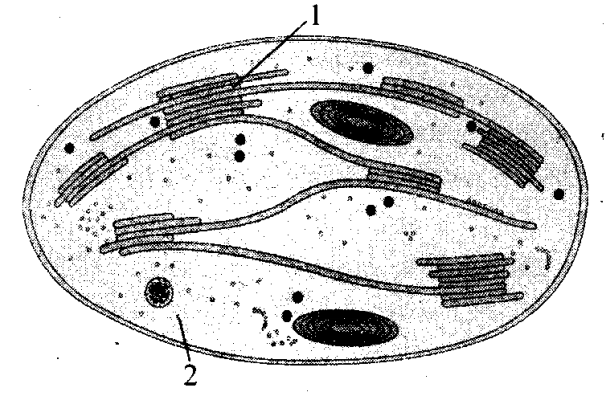
a. Is this structure present in animal cell or plant cell?
b. Can these be passed on to the progeny? How?
c. Name the metabolic processes taking place in the places marked (1) and (2).
Ans: a. Plant cell.
b. Yes, through female gametes.
c. In part (1)— Photophosphorylation. In part (2)—Calvin cycle.

Based on the above equation, answer the following questions:
a. Where does this reaction take place in plants?
b. What is the significance of this reaction?
Ans: a. Lumen of the thylakoids.
b. 02 is evolved during this reaction; moreover, electrons are made available to PS-II continuously.
Q3. Cyanobacteria and some other photosynthetic bacteria do not have chloroplasts. How do they conduct photosynthesis?
Ans: Cyanobacteria and other photosynthetic bacteria have thylakoids suspended freely in the cytoplasm (i.e., they are not enclosed in membrane), and they have bacteriochlorophyll.
Q4. a. NADP reductase enzyme is located on
b. Breakdown of proton gradient leads to release of
Ans: a. Grana-lamellae.
b. Energy.
Q5. Can girdling experiments be done in monocots? If yes, how? If no, why not?
Ans: No, because vascular bundles are scattered in monocot.

Analyse the above reaction and’answer the following questions:
a. How many molecules of ATP and NADPH are required to fix one molecule of C02?
b. Where in the chloroplast does this process occur?
Ans: a. Three molecules of ATP and two molecules of NADPH are required to fix one molecule of C02
b. Stroma of chloroplast
Q7. Does moonlight support photosynthesis? Find out.
Ans: As the intensity of moonlight is much less than the sunlight, so it does not support photosynthesis.
Q8. Some of these terms/chemicals are associated with the C4 Explain.
a. Hatch and Slack pathway
b. Calvin cycle
c. PEP carboxylase
d. Bundle sheath cells
Ans: Though C4 plants have C4 oxaloacetic acid as is the first C02 fixation product they use the C3 pathway or Calvin cycle as the main biosynthetic pathway. C4 pathway is also called Hatch and Slack Pathway
- 1° C02 acceptor in C4 plants is a 3-C molecule PEP (phosphoenol pyruvate) and is present in the mesophyll cells. The enzyme responsible for the fixation is PEPcase (PEP carboxylase) is found only in mesophyll cells. Bundle sheath cells lack PEPcase enzyme.
- C4 acid (OAA) is formed by carboxylation is mesophyll cells; therefore, initial carboxylation reaction occurs in mesophyll cells (also in C3 pathway). OAA forms other 4-C compounds like malic acid or aspartic acid in the mesophyll cells itself, which are transported to the bundle sheath cells.
- C02 released in the bundle sheath cells enters the C3 or the Calvin pathway, a pathway common to all plants. The bundle sheath cells are rich in RuBisCO enzyme (necessary for the C3 or the Calvin cycle), but lack PEPcase.
- Calvin pathway in C4 plants takes place only in bundle sheath cells (because RuBisCO is present) but does not take place in the mesophyll cells because lack of RuBisCO enzyme in mesophyll cells of C4 plants like maize, sorghum, sugarcane, Jowar, Euphorbia, Atriplex,
Q9. Where is NADP reductase enzyme located in the chloroplast? What is the role of this enzyme in proton gradient development?
Ans: The NADP reductase enzyme is located on the stroma side of the membrane. Along with electron that come from the acceptor of electrons of PSI protons are necessary for the reduction of NADP+ to NADPH + H+. These protons are also removed from the stroma.
Q10. ATPase enzyme consists of two parts. What are those parts? How are they arranged in the thylakoid membrane? Conformational change occurs in which part of the enzyme?
Ans: ATPase enzyme consists of two parts:
i.One portion called F0 is imbedded in the membrane and forms a transmembrane channel that carries out facilitated diffusion of protons across the membrane.
ii.The other portion is called ‘Fl and protrudes on the outer surface-of the thylakoid membrane on the side that faces stroma.
The breakdown of the gradient provides enough energy to cause a conformational change in the F, particle of the ATPase, which makes the enzyme synthesise several molecules of energy-packed ATP.
Q11. Which products formed during the light reaction of photosynthesis are used to drive the dark reaction?
Ans: ATP and NADPH
Q12.What is the basis for designating C3 and C4 pathways of photosynthesis?
Ans:The number of carbon atoms in first stable product of carbondioxide fixation is the basis for designating C3 and C4 pathways of photosynthesis.
Short Answer Type Questions
Q1.Succulents are known to keep their stomata closed during the day to check transpiration. How do they meet their photosynthetic C02 requirements?
Ans: Succulent (water storing) plants such as cacti, euphorbias fix C02 into organic compound using PEP carboxylase at night, when the stomata are open.

The. organic compound (malic acid) accumulates throughout the night and is decarboxylated during the day to produce C02.
Q2.Chlorophyll a is the primary pigment for light reaction. What are accessory pigments? What is their role in photosynthesis?
Ans: Accessory pigments are those pigments, which assist in photosynthesis by capturing energy from light of different wavelengths, e.g., chlorophyll b, Xanthophylls and carotenoids.
Role in Photosynthesis:
- They absorb wavelength of light not absorbed by chlorophyll a and transfer the energy to chlorophyll.
- They also protect chlorophyll a from photo-oxidation.
Q3. Do reactions of photosynthesis called, as ‘Dark Reaction’ need light? Explain.
Ans :ATP and NADPH are used to drive the processes leading to the synthesis of food, more accurately, sugars. This is the biosynthetic phase or dark reaction of photosynthesis. This process does not directly depend on the presence of light but is dependent on the products of the light reaction, i.e., ATP and NADPH, besides C02 and H20.
Q4. How are photosynthesis and respiration related to each other?
Ans: Photosynthesis and respiration are related to each other as
- Both processes take place in double membrane bound organelles.
- In both processes ATP synthesis takes place.
- In both processes electron transport system requires.
Q5. If a green plant is kept in dark with proper ventilation, can this plant carry out photosynthesis? Can anything be given as a supplement to maintain its growth or survival?
Ans: No, this plant cannot photosynthesise in the absence of light. Only sunlight can be given as supplement to maintain its growth or survival.
Q6.Photosynthetic organisms occur at different depths in the ocean. Do they receive qualitatively and quantitatively the same light? How do they adapt to carry out photosynthesis under these conditions?
Ans: Photosynthetic organisms occur at different depths in the ocean. They do not receive qualitatively and quantitatively the same light. The spectral quality of solar radiation is also important for life. The UV component of the spectrum is harmful to many organisms while not all the colour components of the visible spectrum are available for marine plants living at different depths of the ocean. Plants at great depth contains some accessory pigments that can easily capture the light.
Q7. In tropical rain forests, the canopy is thick and shorter plants growing below it, receive filtered light. How are they able to carry out photosynthesis?
Ans: In tropical rain forests, the canopy is thick and shorter plants growing below it called sciophytes (shade loving plants). They can photosynthesise in very low light conditions. They have larger photosynthetic units and hence they are able to carry out photosynthesis in filtered light.
Q8. What conditions enable RuBisCO to function as an oxygenase? Explain the ensuing process.
Ans: In the first step of the Calvin pathway RuBP combines with C02 to form 2 molecules of 3PGA, that is catalysed by RuBisCO.

Q9.Why does the rate of photosynthesis decrease at higher temperatures?
Ans: The rate of photosynthesis decreases at higher temperatures because at high temperatures the enzymes become denatured (destroy).
Q10. Explain how during light reaction of photosynthesis, ATP synthesis is a chemiosmotic phenomenon.
Ans: In the light reaction within the chloroplast, protons in the stroma decrease in number, while in the lumen there is accumulation of protons. This creates a proton gradient across the thylakoid membrane as well as a measurable decrease in pH in the lumen. This gradient is important because it is the breakdown of this gradient that leads to release of energy. The gradient is broken down due to the movement of protons across the membrane to the stroma through the transmembrane channel of the F0 of the ATPase. The ATPase enzyme consists of two parts: one part called the F0 is embedded in the membrane and forms a transmembrane channel that carries out facilitated diffusion of protons across the membrane. The other portion is called F1 and protrudes on the outer surface of the thylakoid membrane on the side that faces the stroma. The breakdown of the gradient provides enough energy to cause a conformational change in the Fi particle of the ATPase, which makes the enzyme synthesise several molecules of energy-packed ATP.
Q11. Find out how Melvin Calvin worked out the complete biosynthetic pathway for synthesis of sugar.
Ans: Just after World War II, among the several efforts to put radioisotopes to beneficial use, the work of Melvin Calvin is exemplary. The use of radioactive C14 by him in algal photosynthesis studies led to the discovery that the first C02 fixation product was a 3-carbon organic acid. He also contributed to working out the complete biosynthetic pathway; hence, it was called Calvin cycle after him. The first product identified was 3-phosphoglyceric acid or in short PGA.
Q12. Six turns of Calvin cycle are required to generate one mole of glucose. Explain.
Ans: The fixation of 6 molecules of C02 and 6 turns of the cycle are required for the removal of one molecule of glucose from the pathway. Hence for every C02 molecule entering the Calvin cycle, 3 molecules of ATP and 2 of NADPH are required. To make one molecule of glucose 6 turns of the cycle are required.
| In | Out |
| Six C02 | One glucose |
| 18 ATP | 18ADP |
| 12 NADPH | 12 NADP |
Q13. Complete the flow chart for cyclic photophosphorylation of the photosystem-I
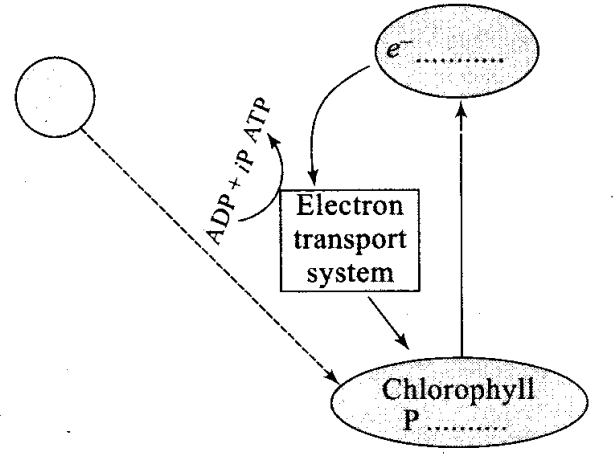
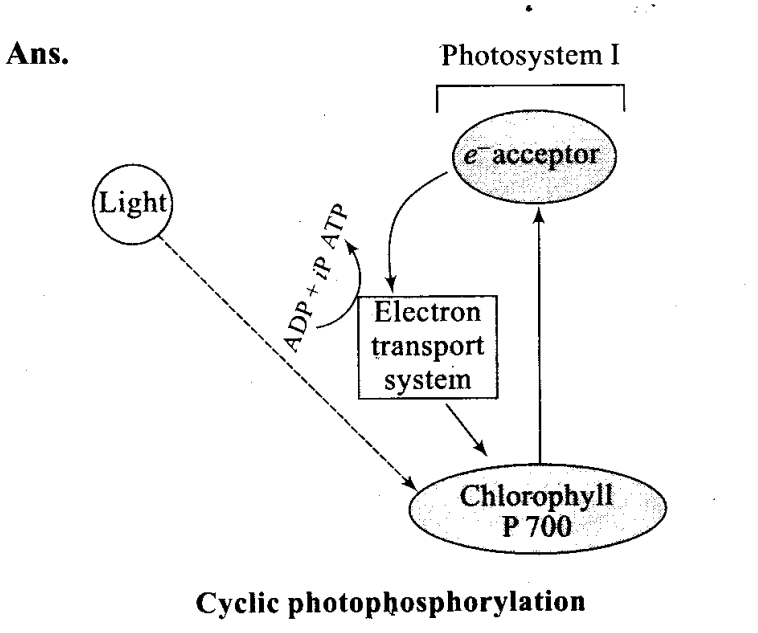
Q14. In what kind of plants do you come across ‘Kranz’ anatomy? To which conditions are those plants better adapted? How are these plants better adapted than the plants, which lack this anatomy?
Ans: On studying vertical sections of leaves, one of a C3 plant and the other of a C4 plant. The particularly large cells around the vascular bundles of the C4 pathway plants are called bundle sheath cells, and the leaves which have such anatomy are said to have ‘Kranz’ anatomy. ‘Kranz’ means ‘wreath’ and is a reflection of the arrangement of cells. The bundle sheath cells may form several layers around the vascular bundles; they are characterised by having a large number of chloroplasts, thick walls impervious to gaseous exchange and no intercellular spaces. Leaves of C4 plants – maize or sorghum lack photorespiration. In addition these plants show tolerance to higher temperatures. Plants that are adapted to dry tropical regions have the C4 pathway.
Q15. A process is occurring throughout the day, in ‘X’ organism. Cells are participating in this process. During this process ATP, C02 and water are evolved. It is not a light-dependent process.
a.Name the process.
b. Is it a catabolic or an anabolic process?
c .What could be the raw material of this process?
Ans: ‘ a. Respiration
b.Catabolic process (actually amphibolic pathway)
c.Glucose
Q16. Tomatoes, carrots and chillies are red in colour due to the presence of one pigment. Name the pigment. Is it a photosynthetic pigment?
Ans: Tomatoes, carrots and chillies are red in colour due to the presence of carotene pigment. It is an accessory photosynthetic pigment.
Q17. Why do we believe chloroplast and mitochondria to be semi-autonomous organelle?
Ans: Mitochondria and Chloroplast are semi-autonomous organelles or endosymbionts of cells because they
i. Possess their own nucleic acid (DNA molecule).
ii. Can form some of the required protein but for most of the proteins these are dependent on nuclear DNA and cytoplasmic ribosome.
iii. Do not arise de novo.
iv. Have membrane similar to those of bacteria.
Q18. Observe the diagram and answer the following.

a. Which group of plants exhibits these two types of cells?
b. What is the first product of C4 cycle?
c. Which enzyme is there in bundle sheath cells and mesophyll cells?
Ans: a. C4 plants
b. OAA (Oxaloacetic acid)
c. Phosphoenol pyruvate (PEP) is present in the mesophyll cells. Enzyme Ribulose bisphosphate carboxylase-oxygenase (RuBisCO) is present in bundle sheath cells.
Q19. A cyclic process is occurring in C3 plant, which is light dependent, and needs O2 This process does not produce energy rather it consumes energy.
a. Can you name the given process?
b. Is it essential for survival?
c. What are the end products of this process?
d. Where does it occur?
Ans: a. Photorespiration
b. No
c. C02 and NH3
d. Photorespiration involves a complex network of enzyme reactions that exchange metabolites between chloroplasts, leaf peroxisomes and mitochondria.
Q20. Suppose Euphorbia and maize are grown in the tropical area.
a. Which one of them do you think will be able to survive under such conditions?
b. Which one of them is more efficient in terms of photosynthetic activity?
c. What difference do you think are there in their leaf anatomy?
Ans: a. Euphorbia is a CAM plant while maize is a C4 plant. Both of them will be able to survive in the tropical areas.
b. Maize (as it is a C4 plant)
c. Leaves of maize plant show Kranz anatomy which is absent in Euphorbia leaves.
Long Answer Type Questions
Q1. Is it correct to say that photosynthesis occurs only in leaves of a plant? Besides leaves, what are the other parts that may be capable of carrying out photosynthesis? Justify.
Ans: Photosynthesis does take place in the green leaves of plants but it does so also in other green parts of the plants. The mesophyll cells in the leaves, have a large number of chloroplasts. Usually the chloroplasts align themselves along the walls of the mesophyll cells, such that they get the optimum quantity of the incident light.
• Photosynthetic or Assimilatory roots: They are green roots which are capable of PHS, e.g., Trapa bispinosa (water chestnut = Singhara), Tmospora (Gillow or Gurcha), Podostemum.
• Some plants of arid regions modify their stems into flattened (Opuntia), or fleshy cylindrical (Euphorbia) structures. These modified stems of indefinite growth are called phylloclades. They contain chlorophyll and carry out photosynthesis.
• One intemode long phylloclade or stem which is leaf like is called cladode. Cladode is capable of photosynthesis. Cladode is found in certain xerophytes, e.g., Ruscus and Asparagus.
Q2.The entire process of photosynthesis consists of a number of reactions. Where in the cell do each of these take place?
a. Synthesis of ATP and NADPH _________
b. Photolysis of water _________
c. Fixation of C02 _________
d. Synthesis of sugar molecule _________
e. Synthesis of starch _________
Ans: a. Synthesis of ATP and NADPH: Membrane system (Grana)
b. Photolysis of water: Inner side of the membrane of thylakoid
c. Fixation of C02: Stroma of chloroplast
d. Synthesis of sugar molecule: Stroma of chloroplast
e. Synthesis of starch: Stroma of chloroplast
Q3. Which property of the pigment is responsible for its ability to initiate the process of photosynthesis? Why is the rate of photosynthesis higher in the red and blue regions of the spectrum of light?
Ans: Pigments are substances that have an ability to absorb light, at specific wavelengths. This property of the pigment is responsible for its ability to initiate the process of photosynthesis.
The wavelengths at which there is maximum absorption by chlorophyll a, i. e. in the blue and the red regions, also shows higher rate of photosynthesis.
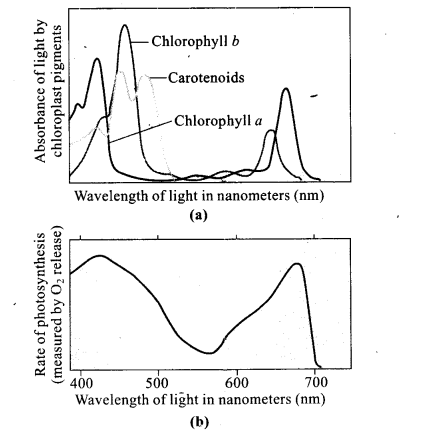
Q4. What can we conclude from the statement that the action and absorption spectrum of photosynthesis overlap? At which wavelength do they show peaks?
Ans: The wavelengths at which therfe is maximum absorption by chlorophyll a, i.e. in the blue and the red regions, also shows higher rate of photosynthesis. Hence, we can conclude that chlorophyll a is the chief pigment associated with photosynthesis.
The action spectrum of photosynthesis superimposed on absorption spectrum of chlorophyll a.
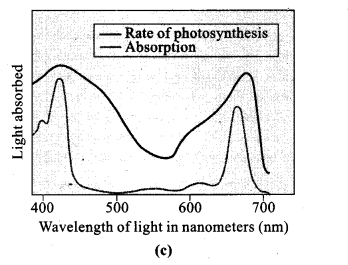
Q5. Under what conditions are C4 plants superior to C3?
Ans: C4 plants are special:
i. They have a special type of leaf anatomy. ‘
ii: They tolerate higher temperatures. _
iii. They show a response to high light intensities.
iv. They lack a process called photorespiration.
v. They have greater productivity of biomass.
Q6. In the figure given below, the light line indicates action spectrum for photosynthesis and the black line indicates the absorption spectrum of chlorophyll a, answer the following:
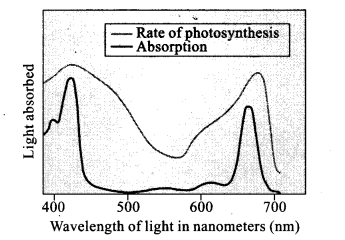
a. What does the action spectrum indicate? How can we plot an action spectrum? Explain with an example.
b. How can we derive an absorption spectrum for any substance?
c. If chlorophyll a is responsible for light reaction of photosynthesis, why do the action spectrum and absorption spectrum not overlap?
Ans: a. Action spectrum of photosynthesis superimposed on absorption spectrum of chlorophyll a. The wavelengths at which there is maximum . absorption by chlorophyll a, i.e. in the blue and the red regions, also shows higher rate of photosynthesis. Hence, one can conclude that chlorophyll a is the chief pigment associated with photosynthesis.
b. Absorption spectrum for any substance can be derived by plotting the different wavelengths of light.
c. Though chlorophyll a is the major pigment responsible for trapping light, other thylakoid pigments like chlorophyll b, xanthophylls and carotenoids, which are called accessory pigments, also absorb light and transfer the energy to chlorophyll a. Indeed, they not only enable a wider range of wavelength of incoming light to be utilised for photosynthesis but also protect chlorophyll a from photo-oxidation. Hence, the action spectrum and absorption spectrum not overlap.
Q7. What are the important events and end products of the light reaction?
Ans. Light reactions or the ‘Photochemical’ phase include light absorption, water splitting, oxygen release, and the formation of high-energy chemical intermediates, ATP and NADPH. Several complexes are involved in the process. The pigments are organised into two discrete photochemical light harvesting complexes (LHC) within the Photosystem I (PS I) and Photosystem II (PS II). These are named in the sequence of their discovery, and not in the sequence in which they function during the light reaction. The LHC are made up of hundreds of pigment molecules bound to proteins. Each photosystem has all the pigments (except one molecule of chlorophyll a) forming a light harvesting system also called antennae. These pigments help to make photosynthesis more efficient by absorbing different wavelengths of light. The single chlorophyll a molecule forms the reaction centre. The reaction centre is different in both the photosystems. In PS I the reaction centre chlorophyll a has an absorption peak at 700 nm, hence is called P700,while in PS II it has absorption maxima at 680 nm, and is called P680.
Q8. In the diagram shown below label A, B, C. What type of phosphorylation is possible in this?
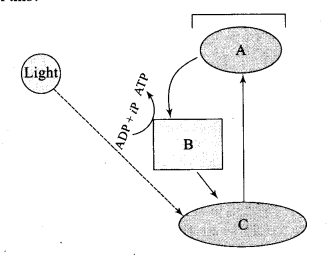
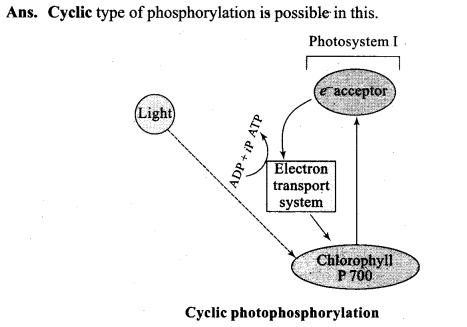
Q9. Why is the RuBisCo enzyme more appropriately called RUBP Carboxylase- Oxygenase and what important role does it play in photosynthesis?
Ans: For ease of understanding, the Calvin cycle can be described under three stages: carboxylation, reduction and regeneration. Carboxylation is the fixation of C02 into a stable organic intermediate. Carboxylation is the most crucial step of the Calvin cycle where C02 is utilised for the carboxylation of RuBP. This reaction is catalysed by the enzyme RuBP carboxylase which results in the formation of two molecules of 3-PGA. Since this enzyme also has an oxygenation activity it would be more correct to call it RuBP carboxylase-oxygenase or RuBisCO.
Q10. What special anatomical features are displayed by leaves of C4 plants? How do they provide advantage over the structure of C3 plants?
Ans: Study vertical sections of leaves, one of a C3 plant and the other of a C4 plant. The particularly large cells around the vascular bundles of the C4 pathway plants are called bundle sheath cells, and the leaves which have such anatomy are said to have ‘Kranz’ anatomy. ‘Kranz’ means ‘wreath’ and is a reflection of the arrangement of cells. The bundle sheath cells may form several layers around the vascular bundles; they are characterised by having a large number of chloroplasts, thick walls impervious to gaseous exchange and no intercellular spaces. C4 plants lack photorespiration. In addition these plants show tolerance to higher temperatures. Plants that are adapted to dry tropical regions have the C4 pathway.
C4 plants are special:
i. They have a special type of leaf anatomy.
ii. They tolerate higher temperatures.
iii. They show a response to high light intensities.
iv. They lack a process called photorespiration.
v. They have greater productivity of biomass.
Q11. Name the two important enzynies of C3 and C4 pathway, respectively? What important role do they play in fixing C02?
Ans: The important enzyme of C3 pathway is RuBisCO and that of C4 pathway is PEPcase.
Carboxylation in the C3 pathway is the fixation of C02 into a stable organic intermediate. Carboxylation is the most crucial step of the Calvin cycle, where C02 is utilised for the carboxylation of RuBP. This reaction is catalysed by the enzyme RuBP carboxylase which results in the formation of two molecules of 3-PGA.
The primary C02 acceptor in the C4 pathway is a 3-carbon molecule phosphoenol pyruvate (PEP) and is present in the mesophyll cells. The enzyme responsible for this fixation is PEP carboxylase or PEPcase.
Q12. Why is RuBisCo enzyme the most abundant enzyme in the world?
Ans: RuBisCo enzyme is the most abundant enzyme in the world because this enzyme is responsible for photosynthesis and present in all green parts of the plants including leaves.
Q13. Why does not photorespiration take place in C4 plants?
Ans: In C4 plants photorespiration does not occur. This is because they have a mechanism that increases the concentration of C02 at the enzyme site. This takes place when the C4 acid from the mesophyll is broken down in the bundle sheath cells to release C02 – this results in increasing the intracellular concentration of C02. In turn, this ensures that the RuBisCO functions as a carboxylase minimising the oxygenase activity.
NCERT Exemplar Class 11 Biology Solutions
- Chapter 1 The Living World
- Chapter 2 Biological Classification
- Chapter 3 Plant Kingdom
- Chapter 4 Animal Kingdom
- Chapter 5 Morphology of Flowering Plants
- Chapter 6 Anatomy of Flowering Plants
- Chapter 7 Structural Organisation in Animals
- Chapter 8 Cell: The Unit of Life
- Chapter 9 Biomolecules
- Chapter 10 Cell Cycle and Cell Division
- Chapter 11 Transport in Plants
- Chapter 12 Mineral Nutrition
- Chapter 13 Photosynthesis in Higher Plants
- Chapter 14 Respiration in Plants
- Chapter 15 Plant Growth and Development
- Chapter 16 Digestion and Absorption
- Chapter 17 Breathing and Exchange of Gases
- Chapter 18 Body Fluids and Circulation
- Chapter 19 Excretory Products and Their Elimination
- Chapter 20 Locomotion and Movement
- Chapter 21 Neural Control and Coordination
- Chapter 22 Chemical Coordination and Integration
NCERT Exemplar ProblemsMathsPhysicsChemistryBiology
We hope the NCERT Exemplar Class 11 Biology Chapter 13 Photosynthesis in Higher Plants help you. If you have any query regarding NCERT Exemplar Class 11 Biology Chapter 13 Photosynthesis in Higher Plants, drop a comment below and we will get back to you at the earliest.
<!–
–>